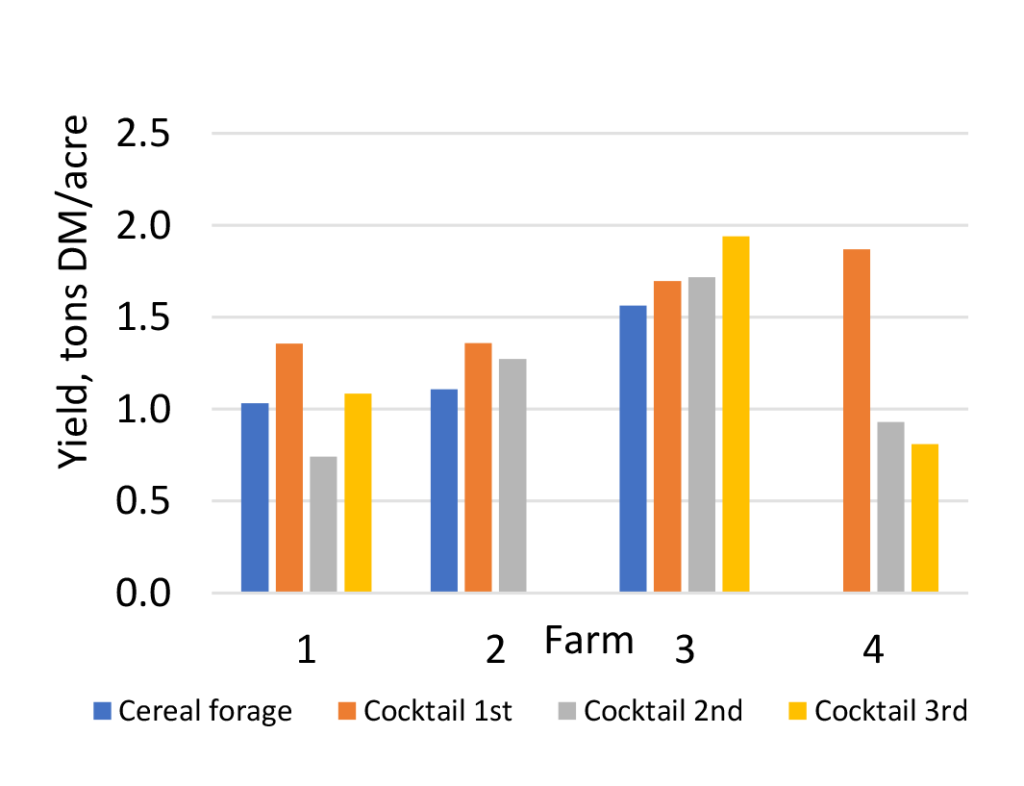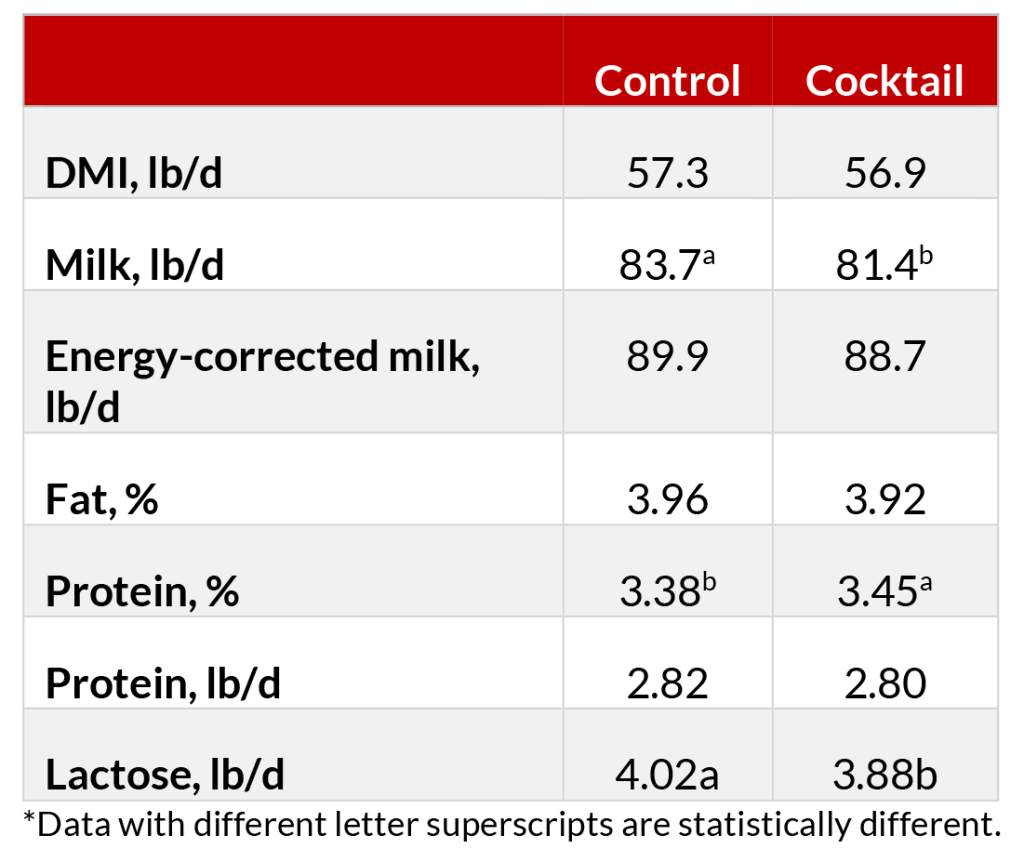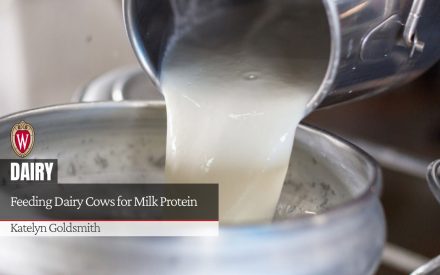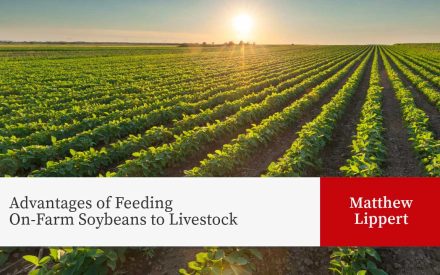Studies to evaluate cocktail forage mixes were conducted in 2021 and supported by the UW Dairy Innovation Hub. Research discussed here includes collection of on-farm data from four farms growing a cocktail forage mix and a lactating cow feeding trial at the UW Marshfield Agricultural Research Station (ARS). Please refer to the “Cocktail Forage Mix Management” article for more information on management.
On-farm forage yield and quality
Three farms used the warm/cool-season mix (60% BMR sorghum-sudangrass or pearl millet, plus 25% Italian ryegrass and 5% each from three or four legumes (usually berseem clover, red clover, and hairy vetch)), while the fourth farm used a mix based on cowpeas (~60%), Italian ryegrass (17%), and assorted other species (millet, alfalfa, red clover, timothy, and turnips).

All farms planted in early June, either after a cereal forage harvest or into a terminated cover crop. Total season forage yields (including cereal forage) averaged 4.6 tons dry matter (DM) per acre with a range from 3.7 to 6.9 tons DM per acre (see Figure 1). The cereal forage yields were 1 to 1.5 tons DM per acre, which are typical in Wisconsin. Cocktail forage mix yields were more variable as the species composition changed at each harvest with first harvest being mostly sorghum-sudangrass, second being a mix of sorghum-sudangrass and Italian ryegrass with some legumes, and third being mostly Italian ryegrass and legumes. The first harvest was the highest yielding (1.4 to 1.9 tons DM/acre). Subsequent harvests were likely affected by species changes and fertilizer type or soil with the farms using commercial nitrogen (N) between cuttings having lower yields (0.7 to 1.1 tons DM/acre), while the farm that applied liquid manure had higher yields (1.7 to 1.9 tons DM/acre). The farm with higher yields harvested sorghum-sudangrass at a taller height. Fertility is key to growth of grasses in these mixes with 30 to 50 lb N per acre per cutting typically applied across farms. Drought was an issue for the farm using a cowpeas-based mix, and only allowed for two cocktail mix harvests (3.7 tons DM/acre total). If sandy soil is present, including a warm-season annual grass may be useful to improve growth.
Forage quality was excellent for the cereal forages (19% protein, 43% NDF, 67% NDFD-30h, and 72% TDN). The cocktail forage quality was lower than expected. Energy was 53 to 68% TDN with the highest sample primarily consisting of Italian ryegrass. Protein content was moderate (8.4 to 16.5%) with protein decreasing across harvests. Fiber content was consistent across cuttings (48 to 56% NDF), except for a third cutting that was mainly ryegrass (42% NDF). Fiber digestibility averaged 55% NDFD-30 (range of 41 to 65%), which is lower than expected considering the use of BMR trait sorghum-sudangrass. The highest value was from a mainly ryegrass harvest. Some harvests were taken when sorghum-sudangrass was taller resulting in lower quality; so, it is critical to harvest at 30 to 36” tall to maintain fiber digestibility.
Lactating cow feeding study
We conducted a 10-week feeding study with 32 lactating cows at Marshfield ARS. Two diets were fed and differed in the haylage source (either alfalfa/grass silage (Control) or cocktail forage mix silage (Cocktail)) with both contributing about 18% of the diet DM (~40% of forage DM), with corn silage making up the remaining forage DM (29% of diet DM). Soybean meal was used to balance the protein across the diets since the cocktail forage mix silage was lower in protein. All other ingredients were similar across diets. Diets mainly differed in starch and fiber with the Cocktail diet having lower starch (24.8% starch) and higher fiber (26.8% NDFom) than the Control (26.4% starch; 25.6% NDFom). Protein was similar at 16.6% of DM.
Results are shared in Table 1. Dry matter intake (DMI) was similar across treatments (57.2 lb DMI average). The cows fed the Cocktail diet had lower milk production (81.4 versus 83.7 lb/day), however when milk fat and protein content were considered, energy corrected milk (ECM) yields were similar (88.2 lb/day for Cocktail and 89.2 lb/day for Control). This was mainly due to higher milk protein and slightly higher milkfat for cows fed the Cocktail diet than the Control diet. This also resulted in similar fat and protein yields for Control and Cocktail. It is worth noting that the cocktail mix silage had poor stability after opening due to a slow feed out rate, with farm staff discarding spoiled silage to reduce effects on feed intake. The impact was likely minimal as feed intake increased during the study. Use of a heterofermentative inoculant may help reduce feed out issues for silage with high sugar levels. Additional analysis for the study is being conducted to measure digestion, greenhouse gas emissions, and economic effects that will be reported in later articles.

Developed by UW–Madison Department of Animal & Dairy Sciences Assistant Scientist and Extension Dairy Specialist Matt Akins for the 2022 Badger Dairy Insight Webinar Series: Ins and Outs of Cocktail Forage Mixes for Dairy Rations, March 1, 2022.
Download Article

 Feeding Dairy Cows for Milk Protein
Feeding Dairy Cows for Milk Protein Best Practices for Roasting Soybeans on Farm for Dairy Diets
Best Practices for Roasting Soybeans on Farm for Dairy Diets Corn Silage Cutting Height Calculator – Background and Guide
Corn Silage Cutting Height Calculator – Background and Guide Advantages of Feeding On-Farm Soybeans to Livestock
Advantages of Feeding On-Farm Soybeans to Livestock


